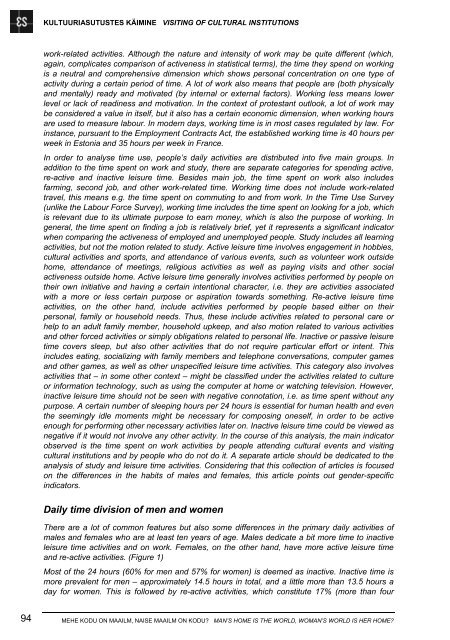MEHE KODU ON MAAILM, NAISE MAAILM ON KODU? - Tartu Ãlikool
MEHE KODU ON MAAILM, NAISE MAAILM ON KODU? - Tartu Ãlikool
MEHE KODU ON MAAILM, NAISE MAAILM ON KODU? - Tartu Ãlikool
Create successful ePaper yourself
Turn your PDF publications into a flip-book with our unique Google optimized e-Paper software.
KULTUURIASUTUSTES KÄIMINE VISITING OF CULTURAL INSTITUTI<strong>ON</strong>S<br />
work-related activities. Although the nature and intensity of work may be quite different (which,<br />
again, complicates comparison of activeness in statistical terms), the time they spend on working<br />
is a neutral and comprehensive dimension which shows personal concentration on one type of<br />
activity during a certain period of time. A lot of work also means that people are (both physically<br />
and mentally) ready and motivated (by internal or external factors). Working less means lower<br />
level or lack of readiness and motivation. In the context of protestant outlook, a lot of work may<br />
be considered a value in itself, but it also has a certain economic dimension, when working hours<br />
are used to measure labour. In modern days, working time is in most cases regulated by law. For<br />
instance, pursuant to the Employment Contracts Act, the established working time is 40 hours per<br />
week in Estonia and 35 hours per week in France.<br />
In order to analyse time use, people’s daily activities are distributed into five main groups. In<br />
addition to the time spent on work and study, there are separate categories for spending active,<br />
re-active and inactive leisure time. Besides main job, the time spent on work also includes<br />
farming, second job, and other work-related time. Working time does not include work-related<br />
travel, this means e.g. the time spent on commuting to and from work. In the Time Use Survey<br />
(unlike the Labour Force Survey), working time includes the time spent on looking for a job, which<br />
is relevant due to its ultimate purpose to earn money, which is also the purpose of working. In<br />
general, the time spent on finding a job is relatively brief, yet it represents a significant indicator<br />
when comparing the activeness of employed and unemployed people. Study includes all learning<br />
activities, but not the motion related to study. Active leisure time involves engagement in hobbies,<br />
cultural activities and sports, and attendance of various events, such as volunteer work outside<br />
home, attendance of meetings, religious activities as well as paying visits and other social<br />
activeness outside home. Active leisure time generally involves activities performed by people on<br />
their own initiative and having a certain intentional character, i.e. they are activities associated<br />
with a more or less certain purpose or aspiration towards something. Re-active leisure time<br />
activities, on the other hand, include activities performed by people based either on their<br />
personal, family or household needs. Thus, these include activities related to personal care or<br />
help to an adult family member, household upkeep, and also motion related to various activities<br />
and other forced activities or simply obligations related to personal life. Inactive or passive leisure<br />
time covers sleep, but also other activities that do not require particular effort or intent. This<br />
includes eating, socializing with family members and telephone conversations, computer games<br />
and other games, as well as other unspecified leisure time activities. This category also involves<br />
activities that – in some other context – might be classified under the activities related to culture<br />
or information technology, such as using the computer at home or watching television. However,<br />
inactive leisure time should not be seen with negative connotation, i.e. as time spent without any<br />
purpose. A certain number of sleeping hours per 24 hours is essential for human health and even<br />
the seemingly idle moments might be necessary for composing oneself, in order to be active<br />
enough for performing other necessary activities later on. Inactive leisure time could be viewed as<br />
negative if it would not involve any other activity. In the course of this analysis, the main indicator<br />
observed is the time spent on work activities by people attending cultural events and visiting<br />
cultural institutions and by people who do not do it. A separate article should be dedicated to the<br />
analysis of study and leisure time activities. Considering that this collection of articles is focused<br />
on the differences in the habits of males and females, this article points out gender-specific<br />
indicators.<br />
Daily time division of men and women<br />
There are a lot of common features but also some differences in the primary daily activities of<br />
males and females who are at least ten years of age. Males dedicate a bit more time to inactive<br />
leisure time activities and on work. Females, on the other hand, have more active leisure time<br />
and re-active activities. (Figure 1)<br />
Most of the 24 hours (60% for men and 57% for women) is deemed as inactive. Inactive time is<br />
more prevalent for men – approximately 14.5 hours in total, and a little more than 13.5 hours a<br />
day for women. This is followed by re-active activities, which constitute 17% (more than four<br />
94<br />
<strong>MEHE</strong> <strong>KODU</strong> <strong>ON</strong> <strong>MAAILM</strong>, <strong>NAISE</strong> <strong>MAAILM</strong> <strong>ON</strong> <strong>KODU</strong>? MAN’S HOME IS THE WORLD, WOMAN’S WORLD IS HER HOME?

















